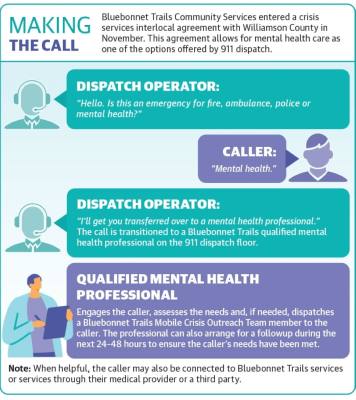In the Williamson County 2022 Community Health Assessment, Bluebonnet Trails Community Services reported it had a total of 98,296 mental health patients in Williamson County in 2020, and that mental health care made up 64.1% of services the nonprofit health-based organization provided.
Other Georgetown mental health providers have also seen and responded to an increased demand for services.
“As Williamson County continues to expand and the population rises and stigma around mental health services decreases, more people will begin to seek help,” said Erin Basalay, CEO of Georgetown behavioral health hospital Rock Springs.
Private care in Georgetown
In March, Rock Springs announced a 24-bed expansion. Basalay said this $6 million project, which includes added dining and mechanical space, will increase the hospital’s ability to provide mental health and substance use treatment.
“By expanding our facility ... we can provide high-quality treatment in our community, which reduces the need for Williamson County residents to leave the county to secure services,” Basalay said.
She said the facility has a consistent demand for its services, estimating 80% of daily care is mental health-related and 20% is substance use disorders. The center has inpatient, outpatient and military programs.
Basalay said before Rock Springs’ opening in 2014, residents had to travel into Travis County or farther to receive help. Now, the organization serves people from across the country in Georgetown.
Another local mental health provider, the Georgetown Behavioral Health Institute, which opened in July 2014, has also worked to meet the higher demand seen during the pandemic. GBHI had more than 3,000 inpatient admissions in 2021 and more than 1,300 through April 2022, Executive Assistant Rick Lopez said.
GBHI serves patients age 12 and up at its 118-bed inpatient and outpatient facility. The facility also offers veteran services, individual and group therapy, substance abuse help and detox care. GBHI has specific adolescent and geriatric wings and offers one of the only psychiatric intensive care units in Central Texas.
“Patients gain skills in the areas of developing healthy boundaries, learning how to appropriately express emotions, using effective communication skills, increasing self-esteem, managing anger and developing life skills,” Lopez said.
Answering emergency calls
Bluebonnet Trails Community Services recently partnered with Williamson County to address the growing demand for mental health care by embedding a mental health professional in the 911 dispatch center.
Under the agreement, which took effect in November, mental health care is one of the emergency services options available when a person calls 911 in addition to fire, emergency medical services and police.
“This partnership eliminates the stigma of mental illness, recognizing it among traditional assistance when persons may be in distress,” BTCS Executive Director Andrea Richardson said.
This year, a total of 133 mental health calls have been made to 911 dispatch in Williamson County, 62 of which were diverted away from law enforcement, according to Bluebonnet Trails data.
With locations throughout Central Texas, BTCS offers a variety of behavioral health services as well as early childhood intervention and family health care. Additionally, at its Georgetown campus, the San Gabriel Crisis Center, there is a 12-bed crisis respite unit—a time-limited facility that helps adults and children while providing relief to the primary caregiver. A typical length of stay ranges from one to 10 days.
Going the extra mile
In some events, the Williamson County Crisis Intervention Team, or CIT, will be dispatched to calls made by deputies in the field or the Williamson County 911 Communications Center.
Lt. Frank Saenz with the Williamson County Sheriff’s Office said the CIT’s primary function is to see if a person meets the criteria for mandatory hospitalization. However, he said the CIT works to resolve mental health calls in less restrictive ways by finding a loved one to care for the person or by taking them to the BTCS respite center. According to Saenz, the CIT receives an estimate of 70 direct calls a month.
“We fit a lot of different roles; we don’t just limit ourselves to one thing, which is crisis,” Saenz said. “Anything that could use our services and expertise, we will be involved with.”
Each member of the crisis team is licensed by the state of Texas with specific training in mental health, crisis intervention, first aid and cardiopulmonary resuscitation and are licensed peace officers with the Williamson County Sheriff’s Office.
While the CIT serves unincorporated areas in the county, Georgetown Police Capt. Roland Waits said the department also believes emergency detention should be the last resort.
“We recognize the mental health crisis is being experienced by many,” Waits said. “Mental health calls for service are not a one-size-fits-all when it comes to placement or services needed. This is why officers will spend as much time as necessary to help obtain the appropriate care.”
Child-focused support
Georgetown ISD launched its School-Based Therapy team full time during the 2021-22 school year.
Headed by Heather Moeller, GISD’s social-emotional learning and mental health specialist, the team had 321 referrals, resulting in 1,227 SBT sessions.
Moeller said in order to be referred for SBT, a student meets with their school counselor first. If additional support is needed, the student will be made eligible for SBT and will attend six to 12 sessions. Moeller said most referrals were for seventh to 10th grade students.
“All learning has an emotional component,” Moeller said. “If our job is to create experiences that prepare students to work and cooperate with the world, then we cannot fail to address the emotional undercurrent of learning.”
Editor's note: This story, which first appeared in the Georgetown June 2022 edition, is part of Community Impact Newspaper's annual health care edition.








